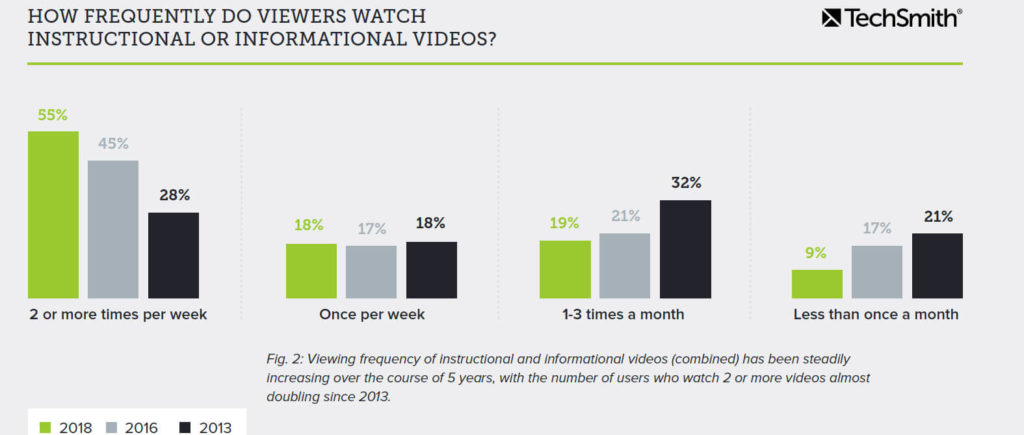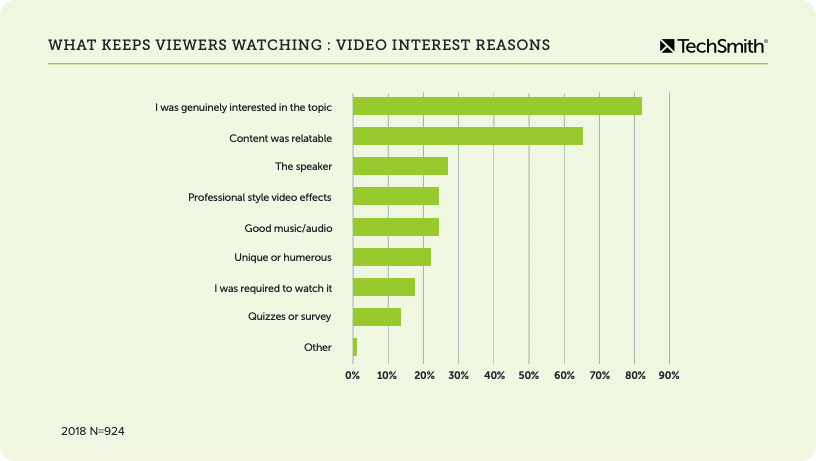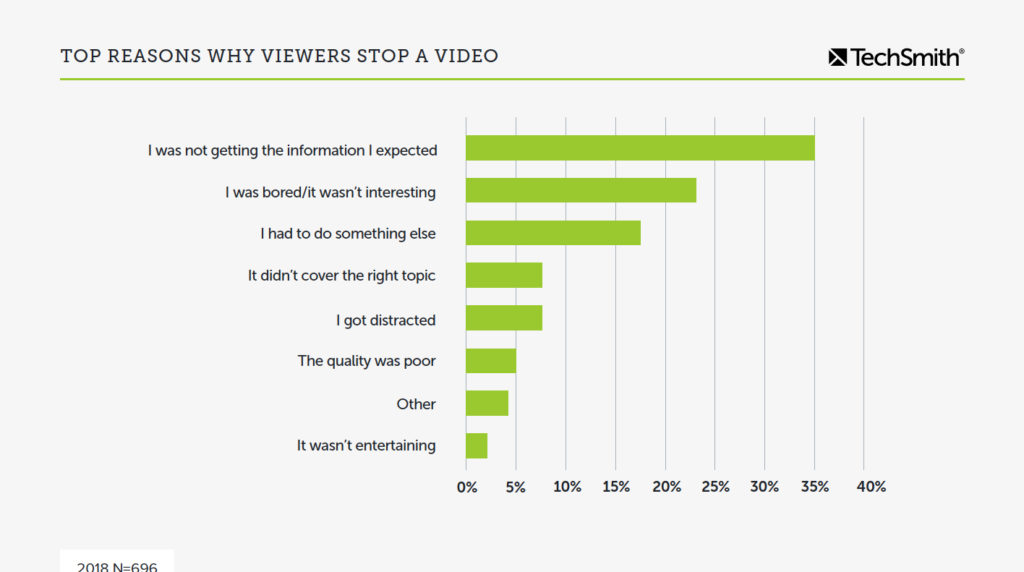User Interface Design Training Videos
Video is one of the most popular ways to deliver and consume content. That's not changing anytime soon. And training videos are one of the best ways to share knowledge or information.
Facebook, Twitter, and YouTube all encourage people to watch and share short, informal videos. And your customers are looking for videos to solve their problems more than ever before.
Make your own training video (Free template!)
Need to make a training video? Download a free trial of Camtasia and a free video template to quickly and easily make your own videos.
Download
If fact, according to a Pew Research study, 87% of users said that YouTube is important for helping them figure out how to do things they haven't done before.
TechSmith's own research shows that people increasingly turn to video for their own learning needs. In 2018, 55% of people surveyed reported watching two or more informational or instructional videos. That's up from 45% in 2016 and 28% in 2013.

So, it's no secret that video is important. And this makes customers particularly receptive to video as they try to learn your product or service.
That means trainers, instructional designers, and anyone else tasked with training customers should be creating instructional videos as part of their customer education program.
Here's what you'll learn:
- What is a training video?
- Why should you create training videos?
- Types of training videos you can create.
- Tips for making your training videos more effective and engaging.
- Where to host your training videos.
- Six easy steps to creating your own training videos.
What is a training video?
Simply put, a training video is video-based content that shows someone how to do something.
Whether it's an employee training video, a software tutorial for customers, or a general topic like how to change a tire, a training video is dedicated to educating or instructing viewers on a specific topic to teach a skill or share knowledge.
Why create training videos?
Video is the perfect media for how-tos and training because you can both show and tell viewers what they need to know. Plus, video is inherently more engaging than text-only methods.
Think about it. Which would you rather do: Read 10 pages of black and white text telling you how to do something or watch a video that shows you exactly the steps to take?
If you're still wondering why you should even bother creating videos, here are a few key benefits you can get from creating videos this year:
- Drive traffic to your website
- Improve Google search results
- Take burden off your tech or customer support team
- Improve your customer satisfaction
- Create smarter customers and users
- Grow your business
How to make an effective training video
Even if you've never made a video, you can make highly effective training videos. They key lies in having the right software and a little guidance. I use TechSmith Camtasia to make all of my videos, and I highly recommend it.
Camtasia is easy enough that literally anyone can use it, but powerful enough that even seasoned video pros will find it satisfies nearly all their video needs.
But, don't bust out that video editor quite yet. There are a few key steps that will help ensure success.
Step 1: Pick your topic

The first thing to do when creating training videos is to select a useful, relevant topic. People are incredibly quick to abandon videos that don't provide the relevant information, so selecting a topic of interest and importance to your audience is critical.
In fact, our research shows that the number one reason people keep watching a video is because they were genuinely interested in the topic.

Conversely, the number one reason they stop watching is because they weren't getting the information they expected.

So selecting the right topic for your audience is incredibly important.
And, to select the right topic, first you need to know who your audience is.
You must develop a thorough understanding of your audience and their needs. Take time to do research that identifies the topics they're most interested in or most need help with. Tailor your research methods to the location and size of your audience.
If your assignment is to train your customers, then you might conduct interviews with them.
If you're creating documentation for a larger audience, then a survey might be an ideal way to collect information.
Consider the availability of online forums and other resources as a way to guide you as you refine your topic.
Hone your topic to a single, focused idea. If you're having trouble doing that, consider breaking it into two topics, with the second building on the first.
A series is an excellent way to make training videos that are useful and easy to digest.
Step 2: Choose the type of training video you want to create

The next step in creating an engaging training video is to choose a format. As you start to work on the video, consider the resources available, your timeline, and stakeholder expectations.
Different types of training videos take different levels of time and effort to complete.
Similarly, different formats will lend themselves to different types of knowledge sharing. So it's important to know the strengths and weaknesses of each.
For example, you probably don't want to try to cover a super-complex topic in a microvideo, and ascreencast probably won't work for a physical product demo.
Here are some formats you might choose for your training video.
Screencast
A screencast is a recording of your computer screen. If you are training people on a new software or computer system, this will likely be at least a part of your video. Screencasts can range from informal to highly polished productions.
Microvideo
A microvideo is a very short video – five to fifteen seconds – that demonstrates a single process or idea. Sometimes microvideos don't have narration but instead rely on visuals or text on the screen. This might be a good choice if you have a number of simple processes to teach that don't take up enough time to warrant creating a longer training video.
Presenter video
For live training, consider recording it to create a presenter video. Then, you can edit the recording and use it as part of your learning program.
If you're training people on processes, a product demo video may be the right choice. In these videos, someone usually acts as a "host" and shows the viewers how a particular product, service, or process works. Many of the DIY videos on YouTube use this format.
Role play
In a role play video, a scenario is acted out to help viewers picture and better understand the way a particular interaction should go. They are good for training viewers on how to handle things like sales calls, technical support processes, and other social interactions.
It takes a bit of acting, but if you're training soft skills, this format might be the best bet as it helps viewers picture actual circumstances and situations.
Animation
Animated explainer videos use text and graphics to get their message across. They take some technical and artistic know-how to create, but they're great for engaging your audience.
Interactive video
Interactive videos are a newer format. One way to think of these is like a "choose your own adventure" video where viewers are asked to respond to situations and then see how things play out depending on their decision. They can be a good way to get your viewers involved.
If you want people to experience how different decisions play out, you might give this a try.
Step 3: Script and storyboard

I'm sure when you think about your video a clear picture emerges in your mind. The scenes layout in order, the visuals are neat, and the words just need to be said aloud.
Of course, if you go straight to recording your video without any prep work, it becomes clear that all of these things are not as organized and perfect as they appear in our imagination.
I know because I have done it. Just because we can't go straight to producing a video, doesn't mean we don't truly have a great video in mind.
It just demonstrates the importance of getting those words, visuals, and scenes out of our minds and onto paper in the form of a script and/or storyboard.
The first and most important prep task is to write a script. Start a document in your favorite word processor and start writing what you want to say.
If you're doing a screencast or microvideo that involves screen recordings, go through the process you plan to show. It might help to think of how you'd explain the process if someone from your audience was sitting with you.
After scripting, create a storyboard. A storyboard demonstrates the visual sequence of a video through simple sketches or images.
I usually capture a few screenshots or take pictures to get a concrete idea of what I want to show in my video. Your storyboard shouldn't take long to put together, and you don't need to agonize over sketching anything beautiful. Stick figures work just fine.
This step will give you a better idea of your overall video length before you begin recording or editing.
Step 4: Recording and editing your training video

Alright, once you've done all the prep work, you can start recording. You don't have to be a video pro to get great video, either. Anyone can record an excellent screencast with just a little practice. And you probably have the technology in your pocket (Hint: smartphone camera) to record a great video if you've chosen to do a role-play or demonstration video.
Once you've recorded your footage, there are a number of ways to edit your video so it's visually engaging.
Leverage existing assets and templates
TechSmith Assets is a great way to start work on your video.
Use a video intro, outro, and lower thirds templates that can be edited to match company and brand standards to get started.
Then pick from over 800,000 resources, including motion backgrounds, animations, images, and music to get the media you need.
Annotations
In screencasts and other videos, annotations are a great way to draw attention to particular things. Arrows and shape callouts can even be combined with animations and text to keep viewers' attention where it needs to be.
Text overlays
Placing text on your video helps you keep things visually intriguing while hammering home key points. Use it in lower thirds graphics to introduce speakers or emphasize a point or idea.
Animations
Make text and shapes move into your video or along the screen. Animations are excellent for keeping visuals varied and intriguing in your learning videos.
Custom animations are one option, but Camtasia Behaviors are an easy way to quickly add creative movement to text, shapes, and other graphics in your videos.
Show the speaker
Don't be afraid to show the narrator in your videos. In screencasts, this is done by recording your webcam and then switching to that footage at opportune moments, usually the beginning and end.
Just be sure you're looking at the camera!
Add some interaction
Interaction is a technique that is gaining traction in corporate training videos. With interactive hotspots, you can send viewers to a specific point in a video, ask them to respond to input or guide viewers to the next step in a series.
Step 5: Review and iterate

Once you've got an early draft video, one of the best things to do is have stakeholders or colleagues review it.
A video review will let you know whether you're on the right track and allow for course corrections, if necessary, before you near a final piece. It's always easier to make changes earlier in a project.
Additionally, having other sets of eyes take a look is the best way to ensure there are no mistakes like typos or design flaws in the final product.
When you're ready to get a review, upload your draft video to TechSmith Video Review, which makes it easy to set up an efficient and effective feedback loop. Then, invite people to review it or enable the public link to send to a group of people. Reviewers can leave comments, mark up the video with shapes, arrows or text, and respond to one another, all within Video Review.
When reviewers have finished providing feedback, use their comments to iterate on your initial video, checking the suggestions off as you address them in your project. Once all of the feedback has been incorporated, go back through the feedback loop, uploading the new version of your video for another round of feedback.
Feedback and review are two of the most effective ways to make a great video, so take your time on this step. It may make sense to go through it two or even three times to make sure your video is just right.
Step 6: Produce, host, and distribute your training video

Finally, we've made it to the last step of creating a top-notch training video: production and hosting. This is the prime time when we make the video available to our viewers.
The first thing to do is to produce the video. Producing your video renders it from the video editor into a video file. You've likely heard of different video file formats, especially the most common and widely used MP4. Unless you have a reason not to, I suggest producing your video as an MP4 at the same size you edited it. For more information on producing a video with Camtasia, check out our tutorial on producing and sharing.
Once the video is produced, it's time to host it.
Hosting is how a video is made available to viewers. YouTube and Vimeo are examples of hosting sites, but there are a number of other ways to host a video, and it's important to choose the one that works best for you.
If you want to make your video public, I would suggest making a YouTube video. YouTube is great for learning content. However, if you want it to be available only to people at your company you can host it on your company's help desk, knowledge base, or website.
Another option is to use Screencast.com, which allows you to host videos and images, and then share a link with others. If you created your video with Camtasia, you can even produce videos straight to Screencast.com, YouTube, or Vimeo.
Now you're ready to make your own training videos!
Make your own training video (Free template!)
Need to make a training video? Download a free trial of Camtasia and a free video template to quickly and easily make your own videos.
Download
Frequently asked questions
What is a training video?
An online training video, whether for employee training or customer training, is a video dedicated to educating viewers on a specific topic with the goal of teaching a skill or knowledge.
How do you make effective training videos?
The number one thing to do to create a high-quality training video is to make sure the content is relevant and relatable. Of course, things like visual effects, music, and other enhancements help, but if the video isn't interesting and informative, your video will fail.
Where can I host a training video?
Hosting is how a video is made available to viewers. YouTube and Vimeo are examples of hosting sites, but there are a number of other ways to host your video content. It's important to choose the one that works best for you.
Can I use YouTube for training videos?
If you want to make your video public, I would suggest making a YouTube video. YouTube is great for learning content. However, if you want it to be available only to people at your company you can host it on your company's help desk, knowledge base, or website.
How do you create a training video?
You don't need a lot of experience or video skills to easily create a training video. You just need a camera or screen recorder, a good microphone, and some video editing software.
Editor's Note: This post was originally published in February 2018 and has been updated for accuracy and comprehensiveness.
User Interface Design Training Videos
Source: https://www.techsmith.com/blog/how-to-make-great-training-videos/
Posted by: biermannoccowell.blogspot.com

0 Response to "User Interface Design Training Videos"
Post a Comment